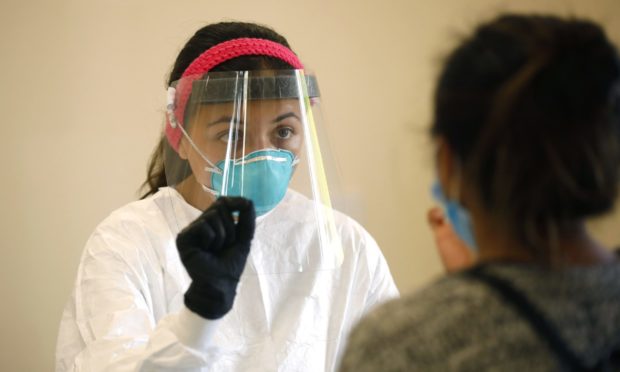Rising Covid cases in Aberdeen, Aberdeenshire, Perth and Kinross and Clackmannanshire are being closely monitored but there will be no tightening of restrictions for the time being, Nicola Sturgeon has said.
In a Holyrood statement, the first minister announced there would be no change to the current anti-coronavirus measures across the country apart from East Lothian, where they have been relaxed.
As expected, more than 2 million people in 11 council areas towards the west of the central belt and including Glasgow will stay in the strictest tier of level four.
Aberdeen City and Aberdeenshire stay in level two while Angus, Fife, Dundee City and Perth and Kinross remain with the slightly stricter level three restrictions.
Highland, Moray, the Shetlands, Orkney and Western Isles continue to be the areas of Scotland with the least restrictive measures, with the first minister confirming they will stay in level one.
In her weekly review of the tier system, Ms Sturgeon said there had been recent rises in Covid cases in Aberdeen and Aberdeenshire but they had been attributed to specific outbreaks which were being managed by local public health teams.
“So our judgement at this point is that these do not require a change in levels, although we continue to monitor them carefully,” Ms Sturgeon said.
The latest figures suggest cases per 100,000 have gone up in Aberdeenshire from 5.1 to 63.9. Ms Sturgeon also said she was looking carefully at Perth and Kinross where cases have increased from 88.8 per 100,000 to 116.5.
Despite this she said Perth and Kinross would remain in level three along with Edinburgh City, Falkirk, Inverclyde, North Ayrshire and Clackmannanshire, which was also under close observation.
“I should advise parliament that we are monitoring Clackmannanshire and Perth and Kinross particularly carefully given recent increases in cases in these areas,” the first minister said.
Cases in Clackmannanshire have gone up from 104.8 to 149.4 per 100,000 people.
Although there were regional variations, Ms Sturgeon maintained there were grounds for “cautious optimism” with the R-number estimated at between 0.8 and 1.
Midlothian ‘a source of concern’
A rise in cases in Midlothian from 61 new cases per 100,000 to just over 97 was a “source of concern” and meant that it would stay in level three “for a period” and not drop to level two as hoped.
The neighbouring area of East Lothian was the only council area to change tier, moving from level three to level two, although Ms Sturgeon indicated Dumfries and Galloway and Argyll and Bute could potentially move down to level one in the “coming weeks”.
Glasgow, Renfrewshire, East Renfrewshire, East Dunbartonshire, West Dunbartonshire, North Lanarkshire, South Lanarkshire, East Ayrshire, South Ayrshire, Stirling and West Lothian will all remain in level four.
Testing scheme
In a few hours’ time, Ms Sturgeon said a drive to expand asymptomatic testing in Scotland would be announced at Holyrood, which would target the areas worst affected by Covid.
The announcement is likely to be based on the mass testing scheme piloted in Liverpool. Testing will also be expanded to designated visitors to care homes, care at home workers and some other NHS staff, the first minister said.
Details will be unveiled by Health Secretary Jeane Freeman alongside plans to start testing students next week so that they can go home for Christmas.
“All students who wish to return home for Christmas, will be offered two Covid tests a few days apart,” Ms Sturgeon said.
“I would strongly recommend that any student who is due to return home over the holiday period gets tested first.
“In addition, students should take extra care in the two weeks before travel – for example, by reducing social contact and going out only for essential reasons.”
Ms Sturgeon added: “By taking extra care – and getting tested before travel – students can help to make the Christmas period as safe as possible for themselves and their families.”
